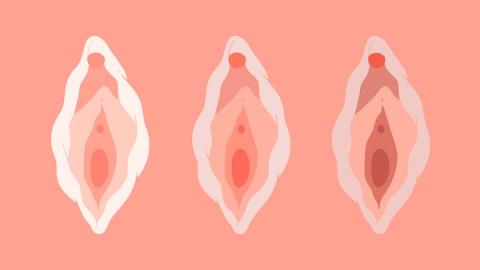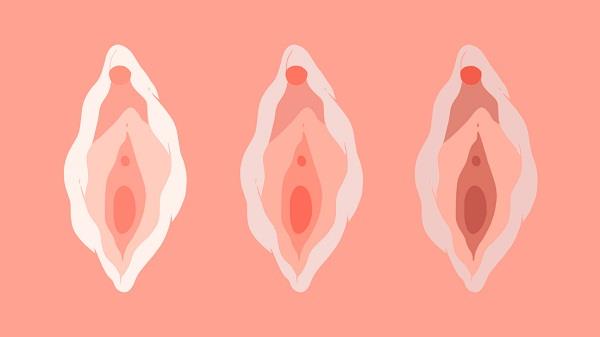Vaginal changes after giving birth are not as scary as you think

Pregnancy is a wonderful experience for every woman. Your body will go through a lot of changes during pregnancy. And this change can last long after giving birth because it takes time to recover. Vaginal changes after giving birth receive a lot of attention from women. However, this may be a delicate matter, so women are often afraid to say it. So, in this article, let's find out with SignsSymptomsList about vaginal changes after giving birth and how to overcome them!
content
- 1. Vagina Outline
- 2. Vagina becomes looser
- 3. Swelling and color change
- 4. Vaginal dryness
- 5. Damage to the perineum
- 6. Change function
- 7. How to treat postpartum vaginal changes?
1. Vagina Outline
The vagina is a tube-shaped organ that extends from the vulva to the opening of the uterus. In terms of location, the vagina is located in the labia minora, located below the urethral opening and above the anus. The vaginal opening is protected by the hymen and labia.
In terms of size, due to the ability of the vagina to expand very well, this part has almost no fixed size. In the normal state, the length of a woman's vagina is about 7-8cm, but when stimulated, it can be up to 11cm deep. Depending on the level of stimulation, the stage of development of a woman, the vagina has different sizes.

Illustration of a woman's vagina
The function of the vagina is very diverse, playing an important role in the reproductive and physiological activities of women.
When you give birth, the baby passes through the cervix and out through the vagina. At this point, the vagina is stretched to allow the baby to pass through. Sometimes, the doctor or midwife will need to cut the episiotomy to facilitate the delivery process.
After giving birth, it's not uncommon for a woman to experience pain or that her vagina is looser or drier than usual. Let's take a look at the changes of the vagina after giving birth!
2. Vagina becomes looser
During a vaginal birth, your vagina will be stretched during delivery to allow the baby to come out. One study found that the pelvic floor muscles involved in childbirth can be stretched up to 3 times their normal size. After birth, these tissues will gradually shrink back to their pre-pregnancy state.
The vagina can become looser after childbirth because the pelvic floor muscles around the vagina are stretched. This change may be more pronounced based on a number of factors. For example how big is your baby, were there any complications during delivery, how many births have you had.

If these changes affect your quality of life, talk to your doctor right away
Usually, your doctor will recommend pelvic floor exercises, such as Kegels, to help strengthen the pelvic floor muscles after delivery. From there, you can quickly return to your pre-pregnancy state. Talk to your doctor to find the best solution.
3. Swelling and color change
Most changes in the appearance of the vulva and vagina after giving birth are temporary. Pregnancy and childbirth can cause swelling or discoloration of the vagina.
However, keep in mind that color changes or swelling can occur whether you have a vaginal delivery or a cesarean section. Because these changes are due to hormonal changes during pregnancy. Depending on how many births you've had, the delivery process may itself lead to swelling.
4. Vaginal dryness
You also often feel that your vagina is drier after giving birth. If this is the case, don't worry too much. This condition is also normal because it is thought to be related to the drop in estrogen levels after giving birth.
For nursing mothers, estrogen levels are lower than for non-breastfeeding mothers. So vaginal dryness may be more pronounced.
Vaginal dryness can lead to a decreased quality of sex life. This is where lubricants can help. Sex life plays an important role in human life. So feel free to share the difficulties you face.
5. Damage to the perineum
Stretching or tearing may occur around the vaginal opening during delivery. These wounds take some time to heal. In some cases, the doctor will cut the episiotomy to make it easier for the baby to come out.
An episiotomy is when a doctor or midwife makes a small incision in the perineum (the area of skin between the anus and the vaginal opening) to create more space for the baby to pass through.
In general, this episiotomy takes about three to six weeks to heal. In some cases, scarring may occur. This scar tissue is usually not noticeable and does not affect the appearance or function of the vagina.
Forceps is an aid during childbirth. The use of forceps can cause damage to vaginal tissue. Most doctors no longer use forceps. However, some cases of difficult birth also need the help of forceps to bring the baby out. If you still have vaginal pain at your first postpartum visit, tell your doctor.
6. Change function
In general, your vaginal function will not change due to pregnancy or childbirth. However, sometimes the pelvic floor muscles that control the vagina are affected.
These pelvic floor muscles surround and support the bladder and vagina. So these muscles can be damaged or weakened during delivery or from the pressures of pregnancy. In some cases, damage to the pelvic floor muscles can lead to complications such as bladder dysfunction or uterine prolapse.

Vaginal changes after giving birth can affect urinary and sexual function
6.1. Urinary incontinence
One of the most common problems women face after giving birth is urinary incontinence. Some women say they leak urine. Especially in relation to strenuous activities, such as jumping, coughing or sneezing. This is common but it is not normal. Talk to your doctor about these issues. This can be improved by strengthening the pelvic floor muscles to prevent urinary incontinence.
6.2. Sexual function
One study found that 91.3% of women reported some sexual problems after childbirth. The reasons could be from sleep disruption to the way a woman feels about her vagina. Nerves in the pelvis can also be damaged or changed during pregnancy or delivery.
The pelvic floor muscles play an important role in sexual function and orgasm. Some women experience a lack of sexual satisfaction or a feeling that the vagina isn't quite "working" as it once was due to weakened pelvic floor muscles.
Pain during sex can also be caused by vaginal dryness. This is due to the hormonal changes of pregnancy and lactation. Don't worry too much, because this dryness is temporary and can be treated with lubricants.

Vaginal changes after giving birth can affect your sexuality. Please share this with your family and doctor about this issue!
If sex is painful for you after giving birth, open up and talk to your partner. Also discuss it with your doctor. Your doctor needs to see if there are complications or infections. After that, we will discuss with you and come up with an appropriate solution. That way, you will be shared by everyone to get through instead of worrying about it yourself.
7. How to treat postpartum vaginal changes?
7.1. Kegels exercises
Fortunately, several exercises can help strengthen the pelvic floor muscles. An example is the Kegel exercise. Exercise helps improve pelvic floor muscle strength, tightens the vagina, improves urinary incontinence, and improves sexual function.
Kegel exercises were born in 1948, created by a gynecologist named Arnold Kegel Henry. This is an exercise for the pelvic floor - the area that protects our genitals. Kegel exercises help activate pelvic muscles and help toned the genitals of both women and men.

Illustrated Kegel exercises - bring many benefits to women
See also the article "What you need to know about Kegel: Pelvic muscle exercises to improve urinary incontinence" for more details on Kegel exercises!
7.2. Surgery
In some severe cases, you may need surgery to repair the pelvic floor and support prolapsed structures, such as a prolapsed uterus or bladder.
The information in this article is for reference only. If you have any questions or concerns about your health, contact your doctor immediately.
In short, after giving birth, women face many changes in their body. Vaginal changes will probably cause many questions and concerns for a woman. Feel free to share with your loved ones and discuss this with your doctor!
Hope the article provides useful information about vaginal changes after giving birth. Do not hesitate to leave questions in the comments section, as well as share the article if you find it useful. Looking forward to receiving your feedback as well as accompanying you in the next articles. SignsSymptomsList is here to help!